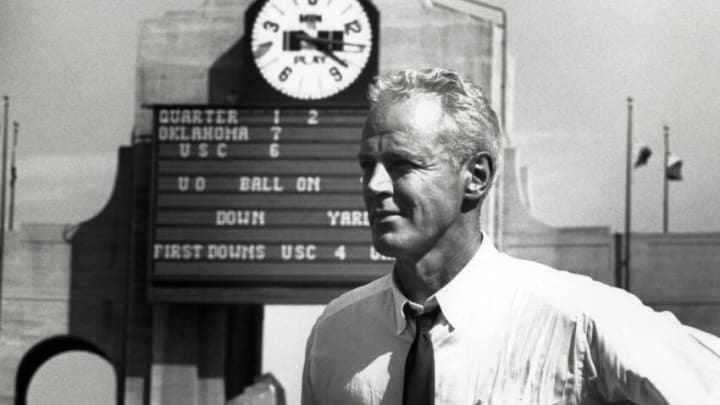Sunday was the birthday of legendary Oklahoma football coach Charles “Bud” Wilkinson.
Wilkinson was born on April 23, 1914, in Minneapolis, Minnesota. Sooner fans will always remember him as the man who introduced an all-new era of Oklahoma football in the 1950s and is credited with putting the Sooners on the map as a national college football power.
After nearly a decade of serving as a college assistant at Syracuse, his alma mater Minnesota, with another coaching legend, Don Faurot, at the Iowa Pre-Flight Seahawks, and even for one season at Oklahoma, Wilkinson was elevated to the head coach’s position at OU for the 1947 season.
Most fans may not know that Wilkinson excelled in multiple sports as a youth. He was a five-sport star in high school and played guard and quarterback at the University of Minnesota, helping lead the Golden Gophers to three national championships (1934, ’35 and ’36). So, Wilkinson knew a thing or two about championship college football before setting foot in Norman.
Jim Tatum was brought in as the new OU head coach in 1946, and he persuaded Wilkinson to join his staff. Unfortunately, Tatum would remain at Oklahoma just one season, leaving after the season for the same job at Maryland. In the view of Sooner football fans, however, that situation proved to be exceedingly fortunate because it resulted in Wilkinson’s promotion to head coach.
Wilkinson remained in the head-coaching position for the Sooners for 17 seasons, at the time the second longest tenure for an Oklahoma football coach (Bennie Owen, another OU coaching legend, was head coach for 22 seasons from 1905-26).
Over those 17 highly memorable and successful seasons, the Sooners won 145 games, lost 29 and tied four, a winning percentage of .815. Those 129 wins, third most in OU football history. Those 129 victories included three national championships (1950, ’55 and ’56), 14 conference championships and, of course, the famous 47-game winning streak that still stands as the longest win streak in college football history.
It was during Wilkinson’s time at Oklahoma that former university president Dr. George L. Cross, while defending a budget request before the combined appropriations committee of the Oklahoma state legislature, was asked by one state senator, “That’s all well and good, but what kind of football team are we going to have this year?” To which the OU president quickly responded with 13 words that will live forever in Oklahoma football history:
"“We want to build a university our football team can be proud of.”"
Wilkinson resigned as OU head coach following the 1963 season and retired from college coaching. In 1965, he began a 10-plus-year career in broadcasting as a college football commentator with ABC and later ESPN.
With the coaching itch still in his blood, Wilkinson tried coaching in the NFL. In two disappointing seasons with the St. Louis Cardinals, the widely popular OU head coach produced a dismal 9-20 record was let go and returned to broadcasting.
Wilkinson also ventured into the political sphere, making an unsuccessful run for a U.S. Senate seat from Oklahoma.
The foundation that Wilkinson built in the OU football program set the course for all the championships and success the Sooners have achieved on the gridiron over the past 75 years.
Former head coach Barry Switzer, who took the reins of Oklahoma football four coaches after Wilkinson, like to say:
"“I didn’t create the monster (OU football). George Cross and Bud Wilkinson did. My job was to feed the monster.”"
The legendary Oklahoma head coach died of congestive heart failure on Feb. 9, 1974, in St. Louis, where he is buried.
”
